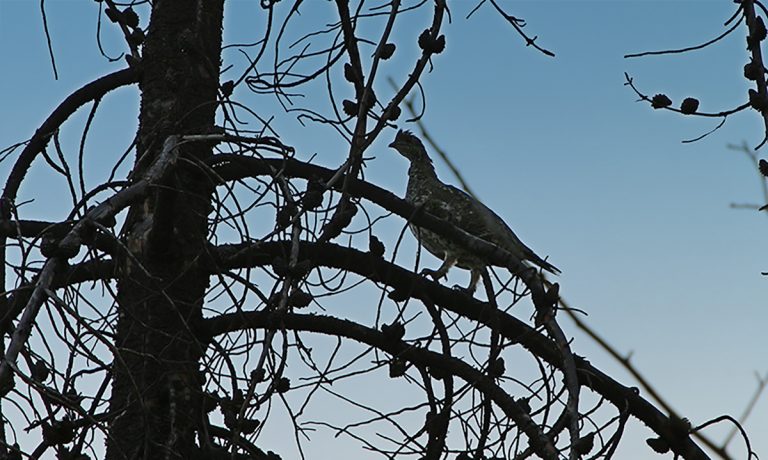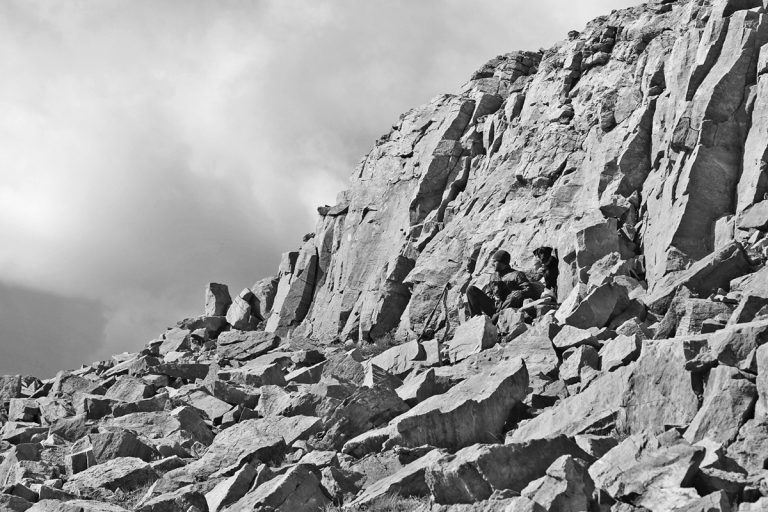Blue Grouse

Also Goes By: Mountain Grouse, Sooty Grouse, Dusky, Pine Grouse
This large grouse is split into two separate species; the Sooty Grouse of the Sierra Nevada and Pacific Coast Ranges and the Dusky Grouse of the Rocky Mountains. Adults have a long tale that is gray at the end. Males will be dark in color (the Sooty Grouse will be especially so). The Sooty Grouse will have a yellow throat sac and wattle while the Dusky Grouse will have a purplish throat sac and a yellow to red colored wattle over the eye during display. Females will be mottled brown. This a fairly large bird, between 12 to 15 inches in length or about the size of a medium weight chicken.
During summer and fall the Blue Grouse enjoy the highland meadows at the edges of confer and mixed forests where they can be concealed under shrubs or a log. As winter approaches, this bird will move upslope to eat conifer needles and roost under the snow.
These birds begin their day foraging a couple of hours after the sun rises with later morning hours being the optimal time to spot them, so there’s no need to set the alarm clock too early. A good hunting dog who can point is ideal to take along, giving the hunter enough time to spot and take aim at his prey. Easily spooked, this bird may fly in a zigzag pattern through the trees once flushed or may fly to a nearby branch and remain stock still and blend with it’s surroundings. As a master of camouflage, the Blue Grouse may be surprisingly easy to pass by. However, once taken, the Blue Grouse makes great table fair.
-
Grouse Camp Lore
It’s quiet. Six inches of fresh powder and temperatures in the teens have subdued the forest. I’ve been on the road since 4 a.m. to get a preview of the coming days. It’s a new area and what could be the start of a new tradition. Having hibernated for the five hour commute, the dogs are…
-
Treed Grouse Dilemma
There are times, especially early in a season, when forest grouse – Dusky, Spruce, Ruffed – have yet to recognize that almost everything loves the taste of grouse. Nearly 70% of these birds will not see a second year. The short hop to the nearest tree seems the earliest learned evasion tactic which can be…
-
Finding Answers
Spike camp was two miles from base — as the raven flies not really that far in this expansive National Forest. But as flatlanders taking on the thin air of elevated places, two miles is a decent gap to begin separating yourself from those less prepared to depart known trails and the easy-breathing comfort of…
-
Two Mountains Offer Different Views
Sitting here in camp staring at these two peaks in Arapaho National Forest. In the last week the dogs and I have visited both. It seems somewhat surreal, not that there is anything particularly outrageous about either. They aren’t the tallest or most dangerous. But the scale is so incredibly different from this low vantage…
-
Lost……again
“I am lost” “Going to shoot. Let me know if you can hear it.” “Hear it?” “I was 50 yards from the truck.” It’s my hunting buddy’s first foray into the realm of the Ruffed Grouse. We’ve hunted a few days now, but this is the first overcast day in an area previously unexplored. It…





